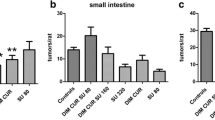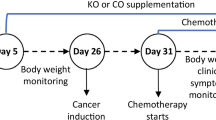Summary
Background
Recent studies have suggested that n–9 fatty acids in olive oil prevent colon carcinogenesis while n–6 PUFA seems to activate this process.
Aims
To evaluate the effects of nutritional–pharmacological combinations made up of olive or soy oilbased diets and the drug sulindac, on colon cancer incidence in a chemically induced (1,2–dimethylhydrazine, DMH) rat cancer model.
Methods
Male rats were assigned to two different dietary regimes based on a standard murine defined diet (AIN–76A) containing either a low (4%) or high (15 %) concentration of olive or soy oil. Some groups also received sulindac in their food (80 mg/kg food) starting from the ninth week following the first DMH or vehicle administration.
Results
Oleic and linoleic acid reached higher levels in plasma and liver lipids when rats were fed high concentrations of olive or soy oil, respectively. Rats fed a low or high soy oil–based diet showed no significant difference in the number of aberrant crypt foci (ACF) in proximal or distal colon specimens. In contrast, rats fed a higher olive oil–based diet developed a significantly lower number of ACF than rats fed a low concentration of olive oil. Addition of sulindac reduced the number of ACF in rats fed the 4%, but not the 15%, soy oil diet. In contrast, the effect of sulindac was significant when combined with both the low and high concentrations of olive oil. High soy oilbased diet or DMH treatment upregulated colon expression of Bcl–2, but not that of cyclooxygenase–2 (COX–2). In contrast, olive oil dose–dependently downregulated the expression of both Bcl–2 and COX–2 in colonic mucosa and also abrogated the upregulation of Bcl–2 by DMH. Olive oil/sulindac combinations were effective in downregulating colonic mucosa Bcl–2 expression (with the 4% oil diet) and COX–2 expression (with the 15% oil diet). These effects were not observed in rats fed the soy oil/sulindac combinations. Caspase–3 activity in colonic mucosa was unaffected by soy oil or soy oil/sulindac combinations. The addition of olive oil, on the other hand, significantly enhanced colonic caspase–3 activity.
Conclusions
Diets containing high levels of olive oil exert a significant protective effect from tumor development that is additive with the inhibitory effect of sulindac. These inhibitory effects are mediated by regulating the expression and activity of key proteins involved in prostaglandin–biosynthesis and apoptosis–induction pathways. It may be concluded that appropriate dietary–pharmacological combination can improve anti–tumor efficacy over either dietary or pharmacological intervention alone.
Similar content being viewed by others
Abbreviations
- ACF:
-
aberrant crypt foci
- Cox–2:
-
cyclooxygenase–2
- DMH:
-
1,2–1,2–dimethylhydrazine
- NSAID:
-
non–steroidal anti–inflammatory drug
- PUFA:
-
polyunsaturated fatty acid
References
Grady WM, Markowitz SD (2002) Genetic and epigenetic alterations in colon cancer. Annu Rev Genomics Hum Genet 3:101–128
Augenlicht LH, Heerdt BG, Mariadason JM, Yang W, Wilson AJ, Fragale A, Velcich A (2002) Environment-gene interactions in intestinal cancer. Eur J Cancer Prev 11:S12–S17
Dommels YE,Alink GM, Linssen JP, van Ommen B (2002) Effects of n-6 and n-3 polyunsaturated fatty acids on gap junctional intercellular communication during spontaneous differentiation of the human colon adenocarcinoma cell line Caco-2. Nutr Cancer 42:125–130
Boudreau MD, Sohn KH, Rhee SH, Lee SW, Hunt JD, Hwang DH (2001) Suppression of tumor cell growth both in nude mice and in culture by n-3 polyunsaturated fatty acids: mediation through cyclooxygenase-independent pathways. Cancer Res 61:1386–1391
Hong MY, Lupton JR, Morris JS, Wang N, Carroll RJ, Davidson LA, Elder RH, Chapkin RS (2000) Dietary fish oil reduces O6-methylguanine DNA adduct levels in rat colon in part by increasing apoptosis during tumor initiation. Cancer Epidemiol Biomarkers Prev 8:819–826
Gatof D, Ahnen D (2002) Primary prevention of colorectal cancer: diet and drugs. Gastroenterol Clin North Am 2:587–623
Slattery ML,Curtin K,Ma K,Edwards S, Schaffer D, Anderson K, Samowitz W (2002) Diet activity,and lifestyle associations with p53 mutations in colon tumors. Cancer Epidemiol Biomarkers Prev 6:541–548
Koornstra JJ, de Jong S, Hollema H, de Vries EG,Kleibeuker JH (2003) Changes in apoptosis during the development of colorectal cancer: a systematic review of the literature. Crit Rev Oncol Hematol 45:37–53
Avivi-Green C,Polak-Charcon S,Madar Z, Schwartz B (2002) Different molecular events account for butyrate-induced apoptosis in two human colon cancer cell lines. J Nutr 132:1812–1818
Rao CV,Hirose Y, Indranie C, Reddy BS (2001) Modulation of experimental colon tumorigenesis by types and amounts of dietary fatty acids. Cancer Res 61:1927–1933
Zock PL (2001) Dietary fats and cancer. Curr Opin Lipidol 12:5–10
Bartoli R, Fernandez-Banares F, Navarro E, Castella E, Mane J, Alvarez M, Pastor C, Cabre E, Gassull MA (2000) Effect of olive oil on early and late events of colon carcinogenesis in rats: modulation of arachidonic acid metabolism and local prostaglandin E2 synthesis. Gut 46:191–199
Hardman WE (2002) Omega-3 fatty acids to augment cancer therapy. J Nutr 132:3508S–3512S
Song JH, Fujimoto K, Miyazawa T (2000) Polyunsaturated (n-3) fatty acids susceptible to peroxidation are increased in plasma and tissue lipids of rats fed docosahexaenoic acid-containing oils. J Nutr 130:3028–3033
Mori TA, Puddey IB, Burke V, Croft KD, Dunstan DW, Rivera JH, Beilin LJ (2000) Effect of omega 3 fatty acids on oxidative stress in humans: GC-MS measurement of urinary F2-isoprostane excretion. Redox Rep 5:45–46
Kratz M, von Eckardstein A, Fobker M, Buyken A, Posny N, Schulte H, Assmann G, Wahrburg U (2002) The impact of dietary fat composition on serum leptin concentrations in healthy nonobese men and women. J Clin Endocrinol Metab 87:5008–5014
Kato T, Hancock RL, Mohammadpour H, McGregor B, Manalo P, Khaiboullina S, Hall MR, Pardini L, Pardini RS (2002) Influence of omega-3 fatty acids on the growth of human colon carcinoma in nude mice. Cancer Lett 187:169–177
Ntambi JM, Bene H (2001) Polyunsaturated fatty acid regulation of gene expression. J Mol Neurosci 16:273–278
Pai R, Soreghan B, Szabo IL, Pavelka M, Baatar D, Tarnawski AS (2002) Prostaglandin E2 transactivates EGF receptor: a novel mechanism for promoting colon cancer growth and gastrointestinal hypertrophy. Nat Med 3:289–293
Tapiero H, Ba GN, Couvreur P, Tew KD (2002) Polyunsaturated fatty acids (PUFA) and eicosanoids in human health and pathologies. Biomed Pharmacother 56:215–222
Turini ME, DuBois RN (2002) Cyclooxygenase- 2: a therapeutic target. Annu Rev Med 53:35–57
Rice PL, Washington M, Schleman S, Beard KS, Driggers LJ, Ahnen DJ (2003) Sulindac sulfide inhibits epidermal growth factor-induced phosphorylation of extracellular-regulated kinase 1/2 and Bad in human colon cancer cells. Cancer Res 63:616–620
Giardiello FM, Yang VW, Hylind LM, Krush AJ, Petersen GM, Trimbath JD, Piantadosi S, Garrett E, Geiman DE, Hubbard W, Offerhaus GJ, Hamilton SR (2002) Primary chemoprevention of familial adenomatous polyposis with sulindac. N Engl J Med 346:1054–1059
Schwartz B, Avivi C, Lamprecht SA (1991) Isolation and characterization of normal and neoplastic colonic epithelial cell populations. Gastroenterology 100:692–702
Friedman A, Sklan D (1995) Effect of dietary fatty acids on antibody production and fatty acid composition of lymphoid organs in broiler chicks. Poult Sci 74:1463–1469
Avivi-Green C, Polak-Charcon S, Madar Z, Schwartz B (2000) Dietary regulation and localization of apoptosis cascade proteins in the colonic crypt. J Cell Biochem 77:18–29
Avivi-Green C, Polak-Charcon S, Madar Z, Schwartz B (2002) Different molecular events account for butyrate-induced apoptosis in two human colon cancer cell lines. J Nutr 132:1812–1818
Avivi-Green C, Polak-Charcon S, Madar Z, Schwartz B (2000) Apoptosis cascade proteins are regulated in vivo by high intracolonic butyrate concentration: correlation with colon cancer inhibition. Oncol Res 12:83–95
Avivi-Green C, Madar Z, Schwartz B (2000) Pectin-enriched diet affects distribution and expression of apoptosiscascade proteins in colonic crypts of dimethylhydrazine- treated rats. Int J Mol Med 6:689–698
Slattery ML, Curtin K, Anderson K, Ma KN, Edwards S, Leppert M, Potter J, Schaffer D, Samowitz WS (2000) Associations between dietary intake and Ki-ras mutations in colon tumors: a population-based study. Cancer Res 60:6935–6941
Franceschi S (1999) Nutrients and food groups and large bowel cancer in Europe. Eur J Cancer Prev 8:S49–S52
Guthrie N, Carroll KK (1999) Specific versus non-specific effects of dietary fat on carcinogenesis. Prog Lipid Res 38:261–271
Potter JD (1996) Nutrition and colorectal cancer. Cancer Causes Control 1:127–146
Bartsch H, Nair J, Owen RW (1999) Dietary polyunsaturated fatty acids and cancers of the breast and colorectum: emerging evidence for their role as risk modifiers. Carcinogenesis 20: 2209–2218
Kossoy G, Yarden G, Ben-Hur H, Kossoy N, Stark A, Madar Z, Zusman I (2001) Comparative effects of dimethylbenz( a)anthacene and a 15 % olive-oil diet on cellular components and expression of apoptosis-related proteins in the spleen and mammary gland tumors of rats. Oncol Rep 8:435–439
Bernstein H, Holubec H, Warneke JA, Garewal H, Earnest DL, Payne CM, Roe DJ, Cui H, Jacobson EL, Bernstein C (2002) Patchy field defects of apoptosis resistance and dedifferentiation in flat mucosa of colon resections from colon cancer patients. Ann Surg Oncol 9:505–517
Chan AO, Broaddus RR, Houlihan PS, Issa JP, Hamilton SR, Rashid A (2002) CpG island methylation in aberrant crypt foci of the colorectum. Am J Pathol 160:1823–1830
Owen RW, Mier W, Giacosa A, Hull WE, Spiegelhalder B, Bartsch H (2000) Phenolic compounds and squalene in olive oils: the concentration and antioxidant potential of total phenols, simple phenols, secoiridoids, lignans and squalene. Food Chem Toxicol 38:647–659
Budiyanto A, Ahmed NU,Wu A, Bito T, Nikaido O, Osawa T, Ueda M, Ichihashi M (2000) Protective effect of topically applied olive oil against photocarcinogenesis following UVB exposure of mice. Carcinogenesis 21:2085–2090
Author information
Authors and Affiliations
Corresponding author
Rights and permissions
About this article
Cite this article
Schwartz, B., Birk, Y., Raz, A. et al. Nutritional–pharmacological combinations. Eur J Nutr 43, 221–229 (2004). https://doi.org/10.1007/s00394-004-0462-6
Received:
Accepted:
Published:
Issue Date:
DOI: https://doi.org/10.1007/s00394-004-0462-6




